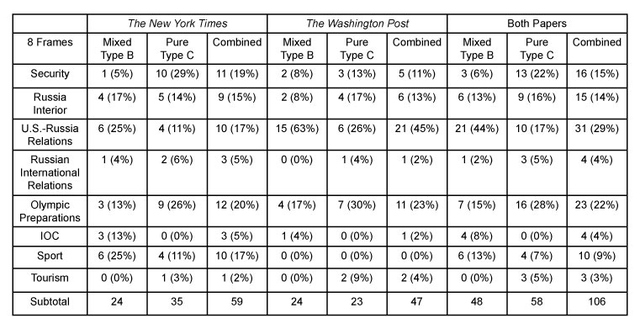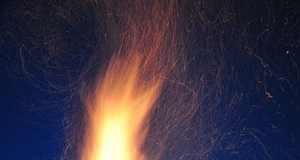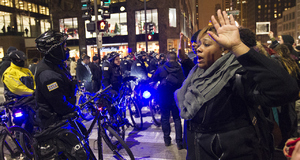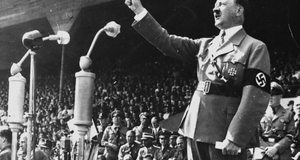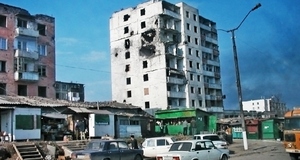From Elon Journal of Undergraduate Research in Communications VOL. 6 NO. 2Human Rights Framing in U.S. Newspaper Coverage of the Sochi Olympic PreparationsIV. Findings and DiscussionOverall Olympic CoverageThe Olympics was most likely to be mentioned passively. As Table 1 shows, the minimal category accounted for 42% of the coverage, followed by 38% for primary and 19% for moderate. This pattern was consistent across both newspapers. In The New York Times, 43% of articles mentioned the Olympics passingly, followed by 37% for primary, and 20% for moderate. The three categories accounted for 42%, 40%, and 18% of articles each in The New York Times. These findings reveal some important trends in coverage. First, both U.S. papers often took similar approaches. The largest proportion of articles published by both newspapers contained minimal mentions of the Olympic Games. In both papers, a large part of the coverage was not specifically about the Olympics, but still the editors and reporters made the editorial decision to mention the Games. These similarities persisted, although a majority of stories were originated by the staff instead of wire services, indicating the editorial direction of the two papers. Coverage of Human Rights IssuesAmong the total 170 articles, 112 covered either purely human rights issues (64 articles under Pure Type A) or partially (48 articles under Mixed Type B), as shown in Table 2. This subsection analyzed articles under only these two types, excluding 58 articles under Pure Type C, which dealt with only topics other than human rights issues. In terms of the portion of articles that were assigned to human rights issues, The New York Times had 58 articles out of 93 — 34 articles (37%) under Pure Type A, and 24 articles (26%) under Mixed Type B. The Washington Post has a higher ratio of 39% and 31%, respectively. *Note. Because of rounding, the sum of some categories might exceed 100%. In terms of attitudes toward Russia through articles that covered human rights issues, these newspapers were different. The Post was more likely to overtly criticize Russia or cover its human rights in a critical way as evident by adopting the critical frame for 59% of its articles, while, The Times was more likely to cover human rights in a neutral way by adopting the neutral frame for 38% of its articles. The Times even published one article that mentioned improvements in human rights violations. This difference between the two papers might be because The Post's sample included more editorials and thus was more likely to have articles that demonstrated an overt opinion about Russia's human rights. On the other hand, The Times tended to cover human rights issues more superficially than The Post. Since critical coverage has a correlation with negative public opinion (Besova & Cooley, 2009; Wanta et al., 2004), this difference might be explained by the difference in the characteristics of their readers: The Post's readers might tend to disapprove of Russia's human rights more than The Times'. Articles that covered human rights violations were divided into seven frames, as shown in Table 4. Among them, freedom of expression was the most common type, appearing in 87% of the articles. There was not much difference between the two newspapers in this area. The New York Times kept freedom of expression coverage at 88% of human rights coverage, the largest proportion; so did The Washington Post with 85%. The next most common type of human rights coverage was violence/threats, appearing in 15% of the articles covering human rights. This frame made up 12% of the coverage in The Times, and 19% of the human rights coverage in The Post. The third most common type of human rights coverage differed for each paper. For The Times, it was unenforced laws, which made up 12% of their coverage, actually tied for second place with violence/threats frame in The New York Times. For The Post, it was labor exploitation, which made up 13% of its coverage. Note. If articles are counted for all categories, their sum exceeds the total because some articles had multiple frames. In both papers the most popular months to publish articles on human rights — and the Olympics in general — were August and December 2013. These periods were the time for major news stories: An anti-gay propaganda law was passed in July in Russia, and December was the month closest to the start of the Sochi Winter Games. Overall, both papers had fairly similar coverage of human rights violations. Freedom of expression made up the vast majority of coverage in both The Times and The Post. These articles dealt mainly with the discriminatory LGBTQ legislation or the suppression of protests. The anti-gay propaganda law illegalized any form of "gay propaganda" that could be seen by or made available to anyone under the age of 18; and the Pussy Riot punk band members were arrested after their anti-government performance in a church. The prominence of these two issues in the newspapers is particularly interesting because Amnesty International pointed out these two cases in its report though these were only matters that the newspapers and the Amnesty International were commonly concerned about. The newspapers began to publish articles about the law starting July, a little later than the Amnesty International, which reported in April 2013 that the anti-gay propaganda law came into effect. This topic then dominated the two papers' coverage through August and continued to receive significant coverage throughout the rest of the year. The Pussy Riot coverage, on the other hand, spiked at the time of their arrest and the time leading up to their releases from prison. This style of coverage makes sense because the incident with Pussy Riot was well suited to episodic, event-style coverage, while the aftermath of the anti-gay propaganda law was suited for more thematic coverage examining the ins and outs and overarching implications of the law or in-depth human interest coverage focusing on those affected by its implementation (Iyengar, 1991). The focus on freedom of expression was probably because of the nature of the journalism profession, whose members appreciates personal freedom. According to Andsager and Miller's (1994) study, journalists were more likely than the general public to support both media rights and freedom of expression and consider them to be integral to the maintenance of the liberty promised by the American government. For example, the Society of Professional Journalists cites the following rights in its mission statement: ". . . to maintain constant vigilance in protection of the First Amendment guarantees of freedom of speech and of the press" (Society of Professional Journalists, 2015). But there were also differences between the NGO and the newspapers: For example, in their dealing with problems in the North Caucasus, Russia's unstable region that had long harbored separatist movements. The newspaper articles about the North Caucasus mainly dealt with the insecurity in the region and how the region related to the security of the Olympic Games, rarely mentioning human rights. In contrast, the Amnesty International Reports for 2012 and 2013 mentioned a number of forced disappearances occurring in the region. As security increased in the region to accommodate for the upcoming Olympic Games, the NGO noted that the local and federal governments increasingly violated human rights or poorly treated the people in North Caucasus. The newspapers covered the increases in security in the region mostly as a response to terrorist attacks and bombings but did not often mention human rights. These findings are consistent with those of Heinze and Freedman (2010), who found that human rights in the North Caucasus often received little coverage from the Western press. Additionally, these findings matched the conclusions of Black and Bezanson (2004), who found that human rights violations tend to take a back seat in coverage when the United States is concerned about terrorism. The U.S. tried to help Russia combat any possible terrorist attack as it was preparing to host the Olympic Games. Coverage of non-human rights issuesThere were 58 articles that dealt with only one frame that is not related to human rights issues (Pure Type C) and 48 articles that dealt with human right issues and non-human right issues (Mixed Type B). For further analysis, only 106 stories under Pure Type C and Mixed Type B were divided into eight frames, as shown in Table 5. According to the combined result for both papers, articles about U.S.-Russia Relations were the most common frame, making up 29% of the total coverage, followed by Olympic Preparations (22%), Security (15%), and Russia Interior (14%). When all the articles mentioning human rights were excluded, however, the top ranks were changed in Pure Type C. The top four in this Pure Type C were in the order of Olympic Preparations (28%), Security (22%), U.S.-Russia Relations (17%), and Russia Interior (16%). Even though combined statistics shared the same three top frames – U.S. – Russia Relations, Security and Russia Interior, analysis of only the Pure Type C saw a shift in their rank orders. The stories on U.S. – Russia Relations were heavily covered in the context of human rights issues, so the issue of U.S. – Russia Relations was shifted from No. 1 frame in combined statistics to No. 3 frame in the Pure Type C. The other two frames accordingly go up by one rank in the Pure Type. (Refer to last three columns in Table 5.) The lowered ranking of U.S. – Russia Relations implies that human rights were often considered salient in articles dealing with the relationship between the two countries. Meanwhile the fact that Olympic Preparations articles made up the largest proportion in the Pure Type C demonstrates that editors and reporters less often saw human rights as salient to telling the story of Russia's Olympic preparation. Instead, these stories tended to focus only on the torch race or solely on Olympic construction, not necessarily the work exploitation and forced evictions that came along with it. When the same kind of analysis was done by newspapers, Olympic Preparation, Security and U.S.Russia mostly occupied the top three categories for each of these two newspapers, although some differences in their rank orders existed between them. In the case of The New York Times, Olympic Preparations (20%) was No. 1 frame under combined statistics, followed by Security (19%) as No. 2, and U.S. – Russia Relations (17%) and Sports (17%) tied for third place. When articles mentioning human rights were excluded by analyzing only the Pure Type C, the pattern changed. The most prominent frame became Security (29%), followed by Olympic Preparations (26%), and Russia Interior (14%), which moved up its rank and beat U.S. – Russia Relations (11%) and Sports (11%). (Refer to columns 2 – 4 in Table 5.) In the case of The Washington Post, the top four frames under combined statistics were in the order of U.S. – Russia Relations (45%), Olympic Preparations (23%), Russia Interior (13%), and Security (11%). When only Pure Type C articles were analyzed, the most prominent frame became Olympic Preparation (30%), followed by U.S. – Russia Relations (26%), Russia Interior (17%), and Security (13%). (Refer to columns 5 – 7 in Table 5) There was one frame that was not affected by human rights issues. All three tourism stories were covered by The New York Times and The Washington Post purely from the standpoint of tourism. V. ConclusionOverall, the results revealed that The New York Times and The Washington Post followed similar patterns through their coverage of the Olympics in Sochi. The Olympics was most likely to be mentioned passively, rather than the main topic of articles when the Olympics was covered. Human rights issues were the dominant topic for the two newspapers, and they were covered mostly thorough the frame of violations of freedom of expression even though The Post was more critical toward Russia than The Times. The emphasis of newspapers on freedom of expression violation was the same with the Annual Reports. But the two groups sometimes differed on terrorist attacks because the former looked at them through the frame of security while the latter did through human rights violation. Future studies could compare how newspapers covered Olympic Games differently, depending on the characteristics of countries. Some countries have respected human rights, others have not. Some countries like Canada and the United Kingdom, both U.S. allies, could be compared with other countries, like Brazil, which is set to host the Rio de Janeiro Olympics in 2016, or China, which hosted the Beijing Olympics in 2008, to examine how U.S. newspapers covered their respective Olympics based on Olympic host countries' relationship with U.S. AcknowledgmentsThe author would like to thank Glenn Scott, associate professor of communications at Elon University, for his mentorship and support and the Lumen Prize Committee for supporting her scholarship, without them, this project would not have been possible. AuthorMichelle Alfini, Broadcast Journalism, Elon University ReferencesAdranovich, G., Burbank, M. J., & Heying, C. H. (2001). Olympic cities: Lessons learned from mega-event politics. Journal of Urban Affairs 23(2), 113-131. Andsager, J. L., & Miller, M. M. (1994). Willingness of journalists and public to support freedom of expression. Newspaper Research Journal, 15(31), 102-114. Besova, A. A., & Cooley S. C. (2009). Foreign news and public opinion: Attribute agenda-setting theory revisited. Ecquid Novi: African Journalism Studies 30(2), 219-242. Black, D. (2007). The symbolic politics of sport mega-events: 2010 in comparative perspective. Politikon: South African Journal of Political Studies 34(3), 261-276. DOI:10.1080/02589340801962536 Black, D. R., & Bezanson, S. (2004). The Olympic Games, human rights and democratization: Lessons from Seoul and implications for Beijing. Third World Quarterly 25(7), 1245-1261. Doi: 10.1080/014365904200281258 Caliendo, S. M., Gibney, M. P., & Payne, A. (1999). All the news that's fit to print?: New York Times coverage of human-rights violation. The Harvard International Journal of Press/Politics 4, 48-69. Doi: 10.1177/1081180X9900400404 Cassara, C. (1998). U.S. Newspaper coverage of human rights in Latin America, 1975-1982: Exploring president Carter's agenda-building influence. Journalism and Mass Communication Quarterly 75(3), 478-486. Retrieved from http://ehis.ebscohost.com/ehost/pdfviewer/pdfviewer?vid=3&sid=8da28e0e-7f8b-4795-8929561931e3a22f%40sessionmgr4005&hid=4105 Dai, J. (2006). Evolving frame: U.S. newspaper coverage of China in the Olympic Games, 1980-2004. Paper presented at Mass Communication Division, the International Communication Association Conference, 2006, 1-20, Dresden, Germany. Entman, R. M. (1993). Framing: Toward clarification of a fractured paradigm. Journal of Communication 43(4), 51–58. Doi: 10.1111/j.1460-2466.1993.tb01304.x Giffard, C. A., & Rivenburgh N. K. (2000). News agencies, national images, and global media events. Journalism and Mass Communication Quarterly, 77(1). 8-21. Doi: 10.1177/107769900007700102 Hachten, W. A. (2005). The troubles of journalism: A critical look at what's right and wrong with the press. Mahwah, NJ: Erlbaum Associates. Heinze, E., & Freedman, R. (2010), Public awareness of human rights: Distortions in the mass media. The International Journal of Human Rights, 14(4), 491-523. Doi: 10.1080/13642980802645804 International Olympic Committee. (2014, September 9). Olympic Charter. Retrieved from http://www.olympic.org/Documents/olympic_charter_en.pdf Iyengar, S. (1991). Is anyone responsible?: How television frames political issues. Chicago, IL: The University of Chicago Press. Liu, J. H. (2007). Lighting the torch of human rights: the Olympic Games as a vehicle for human rights reform. Northwestern Journal of International Human Rights, 5(2), 213-235. McCombs, M. E., & Shaw, D. L. (1972). The agenda setting function of the mass media. Public Opinion Quarterly, 36(2). 176-187. Neier, A. (1996). The new double standard. Foreign Policy, 105, 91-102. Retrieved from http://www.jstor.org/stable/1148975 Neuendorf, K. A. (2002). The content analysis guidebook. Thousand Oaks, CA: Sage. Ramos, H., Ron, J., & Thoms, O. N. T. (2007). Shaping the northern media's human rights coverage 19862000. Journal of Peace Research, 44(4), 385-406. Doi: 10.1177/0022343307078943 Roche, M. (2000) Mega-events and modernity: Olympics and expos in the growth of global culture. Routledge, London. chap.1, pp.1-30. Scheufele, D. (1999). Framing as a theory of media effects. Journal of Communication 49(1), 103–122. Doi: 10.1111/j.1460-2466.1999.tb02784.x Society of Professional Journalists (2015). SPJ Missions. Retrieved from http://www.spj.org/mission.asp Wanta, W., Guy G., & Lee, C. (2004). Agenda setting and international news: Media influence on public perceptions of foreign nations." Journalism & Mass Communication Quarterly 81(2), 364-377. Doi: 10.1177/107769900408100209 Xi, C. (2013). Media events are still alive: The opening ceremony of the Beijing Olympics as a media ritual. International Journal Of Communication (19328036) 7, 1220-1235. Yao, J. (2010). The effect of hosting the Olympics on national image: An analysis of U.S. newspaper coverage of host countries with reputation problems. Retrieved from http://lib.dr.iastate.edu/cgi/viewcontent.cgi?article=2658&context=etd Zaharopoulos, T. (2007). The news framing of the 2004 Olympic Games. Mass Communication and Society 10(2), 235-249. Doi:10.1080/15205430701265752 Suggested Reading from Inquiries Journal
Inquiries Journal provides undergraduate and graduate students around the world a platform for the wide dissemination of academic work over a range of core disciplines. Representing the work of students from hundreds of institutions around the globe, Inquiries Journal's large database of academic articles is completely free. Learn more | Blog | Submit Latest in Business & Communications |





